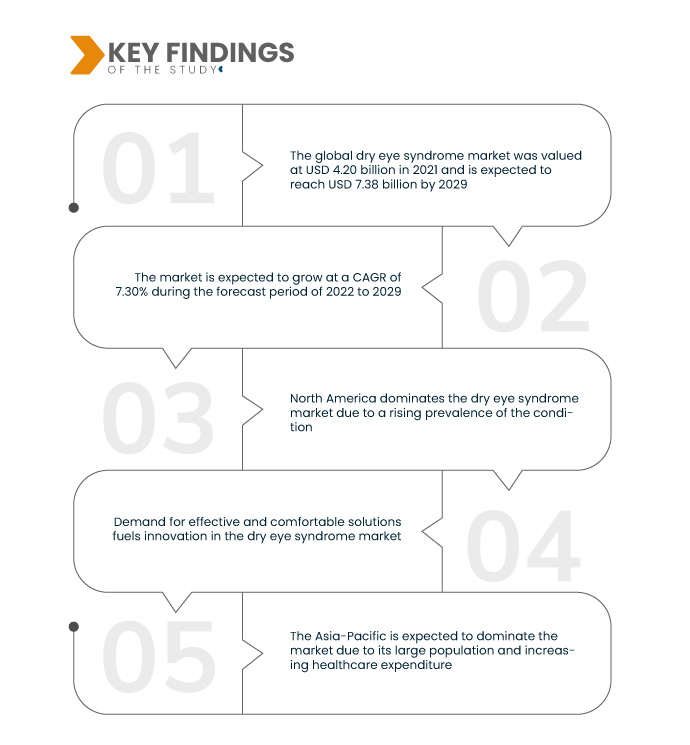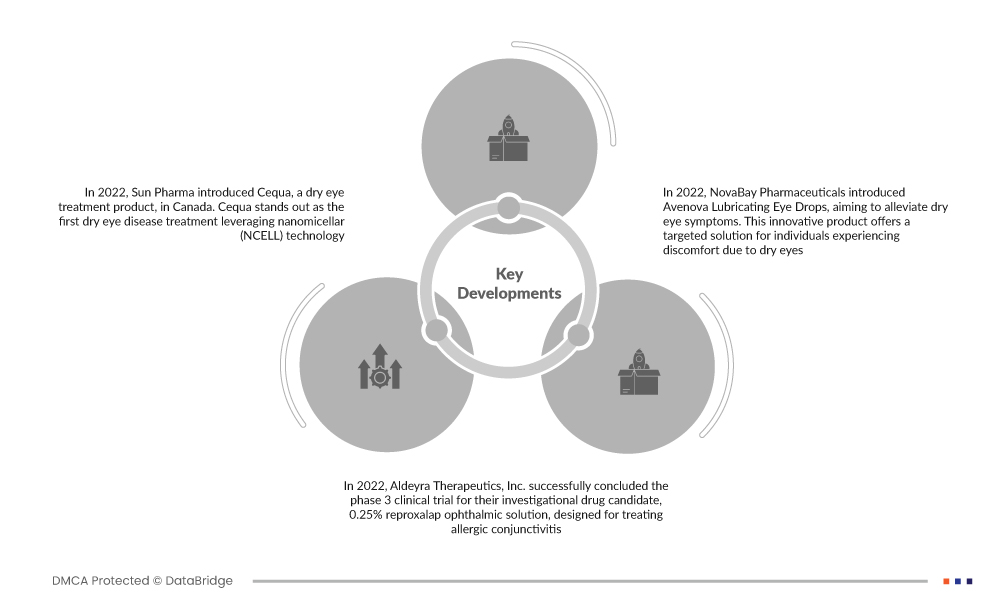The dry eye syndrome market offers diverse solutions, including tear stimulators, artificial tears, and secretagogues, addressing varied patient needs. These products aim to alleviate symptoms through different mechanisms. Dosage types encompass liquids, semi-solids, and others, providing options for personalized treatment. This dynamic market reflects a commitment to enhancing patient comfort and addressing the multifaceted nature of dry eye syndrome, offering a range of innovative products tailored to individual preferences and conditions.
Access Full Report at https://databridgemarketresearch.com/reports/global-dry-eye-syndrome-market
Data Bridge Market Research analyses that the Global Dry Eye Syndrome Market was valued at USD 4.20 billion in 2021 and is expected to reach USD 7.38 billion by 2029, registering a CAGR of 7.30% during the forecast period of 2022 to 2029. The surge in healthcare expenditure significantly propels the dry eye syndrome market, fostering the development and widespread adoption of advanced treatments. This financial investment supports research, innovation, and the implementation of cutting-edge solutions, ultimately improving patient care and outcomes for individuals with dry eye conditions.
Key Findings of the Study
Aging population is expected to drive the market's growth rate
The expanding aging population is a pivotal driver in the dry eye syndrome market, correlating with an elevated risk of dry eye conditions. As individuals age, physiological changes, and an increased prevalence of age-related factors contribute to dry eye symptoms. This demographic trend underscores the pressing need for effective treatments and drives the market's focus on developing innovative solutions to address the unique challenges posed by dry eye conditions in the elderly, enhancing overall patient care.
Report Scope and Market Segmentation
|
Report Metric
|
Details
|
|
Forecast Period
|
2022 to 2029
|
|
Base Year
|
2021
|
|
Historic Years
|
2020 (Customizable to 2014-2019)
|
|
Quantitative Units
|
Revenue in USD Billion, Volumes in Units, Pricing in USD
|
|
Segments Covered
|
Product Type (Tear stimulators, Artificial Tears, Secretagogue, Others), Dosage Type (Liquid, Semi-solid, Others), Drug Class (Lubricating Agent, Cholinergics, Anti-Inflammatory, Anti-Infectives, Anti-Allergics, Others), Dose (Unit dose, Multi-dose), Medication Type (Prescription (Rx) Drugs, Over The Counter (OTC) Drugs), Container Type (Unit-Dose Vials, Bottles, Tubes), Packaging Type (Plastic, Aluminium, Glass), Type (Brands, Generics), Distribution Channel (Hospital Pharmacy, Retail Pharmacy, Online Pharmacy), End-Users (Hospitals, Homecare, Specialty Clinics, Others)
|
|
Countries Covered
|
U.S., Canada and Mexico in North America, Germany, France, U.K., Netherlands, Switzerland, Belgium, Russia, Italy, Spain, Turkey, Rest of Europe in Europe, China, Japan, India, South Korea, Singapore, Malaysia, Australia, Thailand, Indonesia, Philippines, Rest of Asia-Pacific (APAC) in the Asia-Pacific (APAC), Saudi Arabia, U.A.E, South Africa, Egypt, Israel, Rest of Middle East and Africa (MEA) as a part of Middle East and Africa (MEA), Brazil, Argentina and Rest of South America as part of South America.
|
|
Market Players Covered
|
Eli Lilly and Company (U.S.), AstraZeneca (U.K.), Novartis AG (Switzerland), Johnson & Johnson Private Limited (U.S.), Teva Pharmaceutical Industries Ltd.(Jerusalem), Merck & Co., Inc. (U.S.), Allergan (Ireland), Bausch Health Companies Inc. (Canada), Abbott (U.S.), F. Hoffmann-La Roche Ltd. (Switzerland), Pfizer Inc. (U.S.), GlaxoSmithKline plc (U.K.), Sanofi (France), Merck KGaA (Germany), Otsuka America Pharmaceutical, Inc. (U.S.), Akorn Operating Company LLC (U.S.), Allostera Pharma Inc. (Canada), I-Med Pharma Inc. (Canada), Santen Pharmaceuticals Co. Ltd., (Japan), AFT Pharmaceuticals (New Zealand), Novaliq GmbH (Germany)
|
|
Data Points Covered in the Report
|
In addition to the insights on market scenarios such as market value, growth rate, segmentation, geographical coverage, and major players, the market reports curated by the Data Bridge Market Research also include depth expert analysis, patient epidemiology, pipeline analysis, pricing analysis, and regulatory framework.
|
Segment Analysis:
The global dry eye syndrome market is segmented on the basis of product type, dosage type, drug class, dose, medication type, container type, packaging type, type, end-users, and distribution channel.
- On the basis of product type, the global dry eye syndrome market is segmented into tear stimulators, artificial tears, secretagogue, and others
- On the basis of dosage type, the global dry eye syndrome market is segmented into liquid, semi solid, and others
- On the basis of drug class, the global dry eye syndrome market is segmented into anti-inflammatory, lubricating agents, anti-infectives, anti-allergics, cholinergics, and others
- On the basis of dose, the global dry eye syndrome market is segmented into multi dose and unit dose
- On the basis of medication type, the global dry eye syndrome market is segmented into prescription (RX) drugs, and over the counter (OTC) drug
- On the basis of container type, the global dry eye syndrome market is segmented into unit dose vials, bottles, and tubes
- On the basis of packaging type, the global dry eye syndrome market is segmented into plastic, glass, and aluminium
- On the basis of type, the global dry eye syndrome market is segmented into generics and brands
- On the basis of end-users, the global dry eye syndrome market is segmented into hospitals, specialty clinics, homecare, and others
- On the basis of distribution channel, the global dry eye syndrome market has also been segmented into hospital pharmacy, retail pharmacy, online pharmacy, and others
Major Players
Data Bridge Market Research recognizes the following companies as the global dry eye syndrome market players in global dry eye syndrome market Eli Lilly and Company (U.S.), AstraZeneca (U.K.), Novartis AG (Switzerland), Johnson & Johnson Private Limited (U.S.), Teva Pharmaceutical Industries Ltd.(Jerusalem), Merck & Co., Inc. (U.S.).
Market Developments
- In 2022, Sun Pharma introduced Cequa, a dry eye treatment product, in Canada. Cequa stands out as the first dry eye disease treatment leveraging nanomicellar (NCELL) technology. This innovative approach enhances the bioavailability and physiochemical stability of cyclosporine, boosting its penetration into ocular tissues. The launch signifies a significant advancement in addressing dry eye conditions, offering an effective treatment option with improved therapeutic efficacy and ocular delivery precision
- In 2022, Aldeyra Therapeutics, Inc. successfully concluded the phase 3 clinical trial for their investigational drug candidate, 0.25% reproxalap ophthalmic solution, designed for treating allergic conjunctivitis. The company showcased the trial's clinical data at the American Academy of Optometry 2022 Annual Meeting, marking a significant milestone in advancing potential treatment options for allergic conjunctivitis through rigorous clinical evaluation and presentation of compelling research findings
- In 2022, NovaBay Pharmaceuticals introduced Avenova Lubricating Eye Drops, aiming to alleviate dry eye symptoms. This innovative product offers a targeted solution for individuals experiencing discomfort due to dry eyes. Avenova Lubricating Eye Drops contribute to the growing landscape of dry eye treatments, providing patients with a reliable option to enhance eye moisture and relieve symptoms associated with this prevalent ocular condition
Regional Analysis
Geographically, the countries covered in the global dry eye syndrome market report are U.S., Canada and Mexico in North America, Germany, France, U.K., Netherlands, Switzerland, Belgium, Russia, Italy, Spain, Turkey, Rest of Europe in Europe, China, Japan, India, South Korea, Singapore, Malaysia, Australia, Thailand, Indonesia, Philippines, Rest of Asia-Pacific (APAC) in the Asia-Pacific (APAC), Saudi Arabia, U.A.E, South Africa, Egypt, Israel, Rest of Middle East and Africa (MEA) as a part of Middle East and Africa (MEA), Brazil, Argentina and Rest of South America as part of South America.
As per Data Bridge Market Research analysis:
North America is the dominant region in the global dry eye syndrome market during the forecast period 2022-2029
North America dominates the dry eye syndrome market due to a rising prevalence of the condition. The region's dominance is underscored by an increasing focus from major industry players on innovative technologies. This concerted effort toward novel solutions contributes to a heightened growth rate in the market, reflecting the region's commitment to addressing the challenges posed by dry eye syndrome through advanced therapeutic and technological interventions.
Asia-Pacific is expected to dominate the global dry eye syndrome market in the forecast period 2022-2029
The Asia-Pacific is expected to dominate the market due to its large population and increasing healthcare expenditure. With a substantial demographic base, rising healthcare investments contribute to the expansion of medical services and technologies. This convergence of factors positions Asia-Pacific as a key driver of growth in the forecasted period, emphasizing the region's evolving healthcare landscape and its impact on market dynamics.
For more detailed information about the global dry eye syndrome market report, click here – https://www.databridgemarketresearch.com/jp/reports/global-dry-eye-syndrome-market















